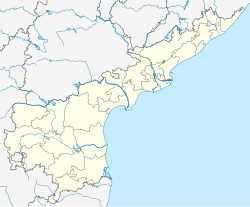Penugonda mandal is one of the 46 mandals in West Godavari district of the Indian state of Andhra Pradesh.[2] The headquarters are located at Penugonda town. The mandal is bordered by Godavari River to north, Achanta mandal to the east, Penumantra mandal and Iragavaram mandal to the south and Peravali mandal to the west.[3]
Penugonda mandal | |
|---|---|
| Coordinates: 16°28′48″N 81°46′52″E / 16.480°N 81.781°E | |
| Country | India |
| State | Andhra Pradesh |
| District | West Godavari |
| Headquarters | Penugonda |
| Government | |
| • Body | Mandal Parishad |
| Area | |
• Total | 71.01 km2 (27.42 sq mi) |
| Elevation | 14 m (46 ft) |
| Population (2011)[1] | |
• Total | 69,317 |
| • Density | 980/km2 (2,500/sq mi) |
| Languages | |
| • Official | Telugu |
| Time zone | UTC+5:30 (IST) |
| Vehicle registration | AP 37 |
Demographics
editAs of 2011[update] census, the mandal had a population of 69,317 in 19,124 Households. The total population constitute, 34,837 males and 34,480 females with a sex ratio of 970 females per 1000 males. 6,535 children are in the age group of 0–6 years, of which 3,334 are boys and 3,201 are girls with a sex ratio of 960. The average literacy rate stands at 77.67% with 48,763 literates of which 25,728 are males and 23,035 are females.[1]
Majority are Schedule Caste with a population of 14,423 whereas Schedule Tribe had a population of 570.[4]
Work Profile
editAs per the report published by Census India in 2011, 31,975 people were engaged in work activities out of the total population of Penugonda mandal which includes 21,847 males and 10,128 females.
According to census survey report 2011, 27,027 workers describe their work as main work, 2,238 as Cultivators, 18,373 person work as Agricultural labourers. 429 are working in Household industry and 5,987 are involved in other works. Of them 4,948 are Marginal workers.[1]
Administration
editPenugonda mandal is administered under Achanta (Assembly constituency)[5] of Narsapuram (Lok Sabha constituency)[6] and one of the twelve mandals that falls under Narasapuram revenue division.
Towns and villages
editAs of 2011[update] census, the mandal has 14 settlements, of which all are villages. Penugonda is the largest and munamarru is the smallest village in terms of population.
The settlements in the mandal are listed below:
- Cherukuwada
- Chinamallam
- Deva
- Ilaparru
- Kothalaparru
- Mulaparru
- Munamarru
- Nadipudi
- Penugonda
- Ramannapalem
- Sidhantham
- Tamarada
- Vadali
- Venkatramapuram
Education
editThe mandal plays a major role in education for the rural students of the nearby villages. The primary and secondary school education is imparted by government, aided and private schools, under the School Education Department of the state.[7] As per the school information report for the academic year 2015–16, the mandal has more than 9,501 students enrolled in over 90 schools.[8][9]
See also
editReferences
edit- ^ a b c "Census 2011" (PDF). The Registrar General & Census Commissioner, India. p. 404. Retrieved 6 November 2017.
- ^ "Penugonda mandal - West Godavari". Retrieved 6 November 2017.
- ^ "Mandals in West Godavari district". aponline.gov.in. Archived from the original on 29 April 2015. Retrieved 6 November 2017.
- ^ "Penugonda Censusindia.in". Retrieved 6 November 2017.
- ^ "TABLE B - Parliamentary Constituencies" (PDF). Delimitation of Parliamentary and Assembly Constituencies Order, 2008. The Election Commission of India. p. 31. Retrieved 6 November 2017.
- ^ "Delimitation of Parliamentary and Assembly Constituencies Order, 2008" (PDF). The Election Commission of India. p. 30.
- ^ "School Education Department" (PDF). School Education Department, Government of Andhra Pradesh. Archived from the original (PDF) on 7 November 2016. Retrieved 6 November 2017.
- ^ "R1.1 SCHOOL INFORMATION". Archived from the original on 8 November 2016. Retrieved 5 November 2017.
- ^ "Student Information Report". Commissionerate of School Education. Child info 2015-16, District School Education - Andhra Pradesh. Retrieved 6 November 2017.

